- Need Any Help: +1 647-760-5505 or
- info@trubicars.ca
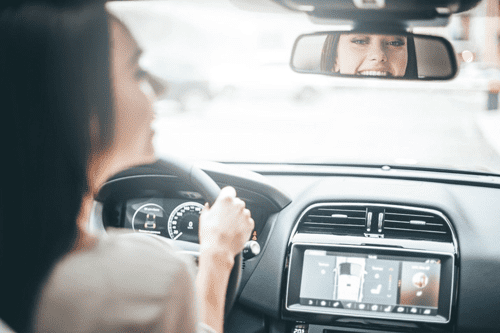
A driver’s mirrors are a needed tool to remain aware of what’s approaching them from behind. Learning to check your mirrors regularly keeps you up to date with the traffic around you. Driving through the city traffic, you should check your mirror roughly every 5 to 10 seconds. You may think that is too often, but it’s all part of the process of keeping track of traffic behind.
If you see a driver behind you with the first check, the second, third, and fourth check, you will be able to determine if the driver behind is gaining on you. You can compare their position in your rear-view mirror after each glance. If the view of the vehicle gets larger in your mirror after each glance, you know it’s gaining on you.
Receiving this valuable information will allow you to adjust your driving and respond to the driver behind safely, such as by changing lanes or increasing your following distance.

Since we all come in different sizes and shapes, we need to personalize how we set up the seat to drive safely. Sitting too far away from the pedals or steering wheel will make it difficult to use them properly. Also, sitting too close to the steering wheel may affect your ability to steer safely and correctly.
To adjust your seat correctly, place your right foot under the brake pedal to the floor and adjust the seat, keeping your right leg only slightly bent. This position will give you enough leg strength to press the brake completely down if you have to brake hard in an emergency. Next, place both hands on the steering wheel at 10 – 2 or 9 – 3. There should only be a slight bend in your arms. If your arms are too straight or stiff, they may stop you from steering smoothly while making routine turns.
The last part is to ensure your body is sitting high enough to see effectively. If your seat does not raise, sit on a cushion or wedge so your eye level would be above three fingers placed on top of the steering wheel.
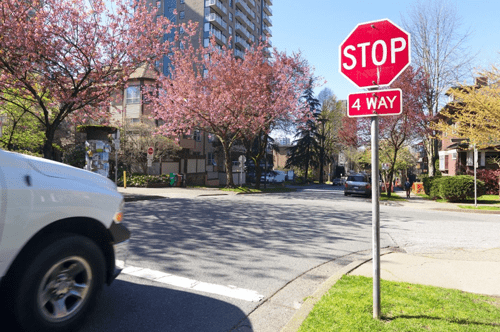
Rolling stops are not only illegal, but they will also cause anyone attempting their road test to fail it. Learning how to make complete stops will not only keep your driving legal but also allow you to become safer on the road.
When you think about it, there is an order when you come to a stop sign. You stop, then check to see if it’s clear, and if it is clear, you proceed. Checking to see if the intersection is clear before coming to a stop can fool your mind. Your mind says it’s clear to go, so you go. You’ve skipped past step 1 of ensuring you’ve stopped first without realizing it.
To ensure you are making a complete stop, ensure you feel the vehicle come to a stopping position. Once that has happened, check the intersection to ensure the way is clear of all vehicles, cyclists, and pedestrians. Once it is safe to proceed, off you go. Following these steps in this order can help you avoid rolling stops.
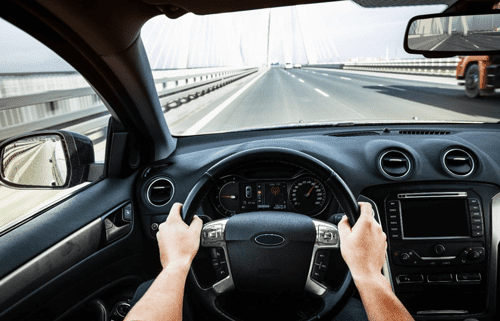
Anytime you’re on a multiple-lane road, you may have the opportunity to change lanes, whether for a parked vehicle or to help you reach your destination. Knowing how to change lanes safely can make it much easier for you during your driving test.
The first step is to look for a gap in the rearview mirror. To know if there is a gap in the next lane, you would need to see the headlights of the other vehicle in that lane. That would give you enough space to safely change lanes in front of them.
Once you see a gap, put on your signal, and check your side mirror on the way to the blind spot. If it’s still clear, look ahead to the lane you wish to enter and gently steer into that lane. Turn your signal off as soon as you’re in that lane so as not to miscommunicate with other drivers in case they think you also want to make a turn. Once your lane change is complete, check your rear-view mirror once again to see what the traffic is like directly behind you.
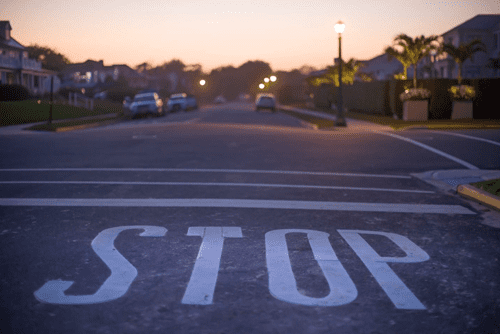
One of the rules of the road which confuses drivers is the right of way. One of the things to remember is that right-of-way is something that is given, not necessarily taken. In other words, although you may think it’s your turn to move, you can only go if the other driver lets you go. Here are the basics.
When two vehicles arrive at an all-way stop together, the driver to the right should be allowed to go first. If one driver arrives and stops before the second driver, they should be allowed to go first. Think of it as “first come, first served.”
The same rules apply if three vehicles stop together at an all-way stop. The driver to the furthest right should be allowed to go first, then the next driver furthest right, and so on. If you are the first vehicle to stop and there is another driver directly opposite you, you should be allowed to go first, even if turning left. The tricky part is the other driver must let you go first.
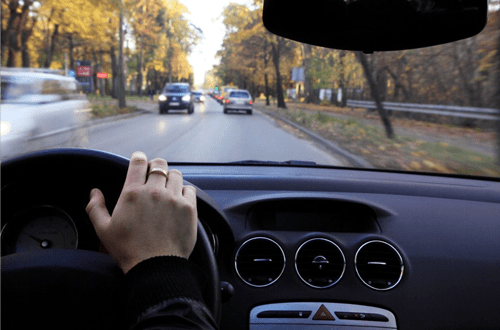
To stop safely while following another vehicle, you should have at least 2 seconds of space between the front of your car and the back of the vehicle ahead of you. This space will also help you look well ahead up the road.
When the back of the vehicle ahead of you passes a fixed object, like a crosswalk, light post, fire hydrant, or tree, begin counting – one thousand and one, one thousand and two, etc. – until the front of your vehicle reaches that same fixed point. Once you have reached “one thousand and two” by the time the front of your car has reached that fixed object, you have a minimum of 2 seconds behind them.
If you have more than two seconds of space between your vehicle and the vehicle ahead of you, that’s even better, but never less than two seconds. If you have less than 2 seconds, ease off the accelerator until you have the minimum of seconds. Having two seconds of space is during ideal driving conditions.
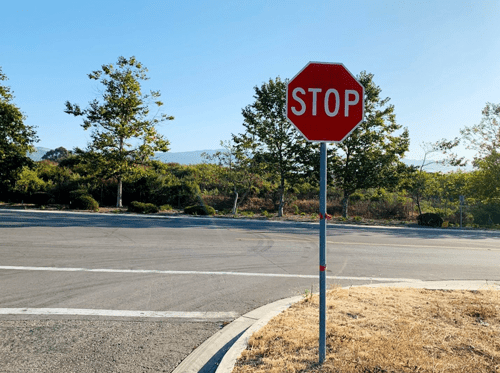
We all know a stop sign tells us we must stop our vehicle but knowing where we should stop should be just as important. Stopping at the wrong place may cause you to fail your road test. Let’s make sure everyone knows where to stop, according to the Highway Traffic Act.
A common myth is to stop beside the stop sign. Think of it this way, the stop sign tells you to stop but not where to stop. The first position to stop is before the white stop line. Considering it’s called a stop line it would make sense to stop there. If there is no stop line, the next place to look for would be the painted crosswalk line on the road. Stopping at that place will allow pedestrians room to cross.
If there are no painted crosswalk lines on the road, you want to stop before the imaginary crosswalk that lines up the sidewalk on both sides of the street. Stopping at that position will allow pedestrians to cross the road safely. And lastly, the last place to stop if the other does not exist is before the edge of the driven part of the road. Learning the order makes your driving smoother and legal.
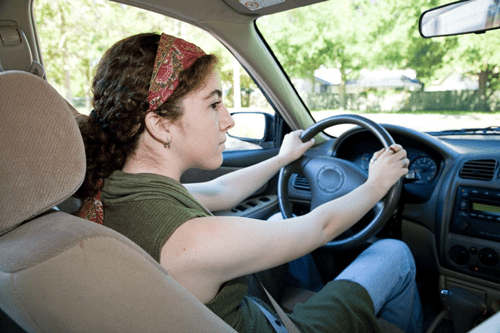
There seems to be an element of trust as drivers but not as pedestrians. As pedestrians, we tend to look both ways before we cross the street. We do that to ensure we won’t get struck by someone driving through a stop sign or red light. Under the same mentality, we should look both ways before moving across the intersection.
We could still be struck and injured by a vehicle going through the stop, even while we drive our vehicle. Doesn’t this make good driving sense? Visit Trubicars.ca for more information to help you learn to become a safe driver and pass your driving test!

Backing up into a parking space is a skill worth learning. It allows you to have better visibility while leaving the parking space, especially after being parked between two larger vehicles. The aisles have more risks in them than your parking space does because of other vehicles and pedestrians. Leaving forward will help you spot vehicles traveling toward you much easier, and you’ll see any pedestrians walking past as well. Learn more at Trubicars.ca!

When you approach a school bus with overhead red lights flashing and it’s stop arm out, you are required by law to stop. This includes if you are following behind or approaching the bus. If there is a median strip down the center of the road, only vehicles approaching the bus from behind must stop. If you are approaching the bus from the rear, ensure you stop at least 20 meters away, which is the length of a transport truck.
Once the overhead lights have stopped flashing and the stop arm is no longer out, you may continue moving again. Not only is it illegal in Ontario to pass a stopped school bus with lights flashing and the stop arms it, but it can also be dangerous. Visit Trubicars.ca for more information!

When you come to a railway crossing, there are a few things to know. Ensure you slow down, listen for trains since you can’t always see them, and look both ways before crossing the tracks. If a train is approaching, stop a minimum of five meters from the closest rail or gate, and do not cross until you know all the trains have passed. If there are signal lights to warn you of a train, wait until they stop flashing, and if the crossing has a gate or barrier, wait until it completely lifts before you cross the tracks.
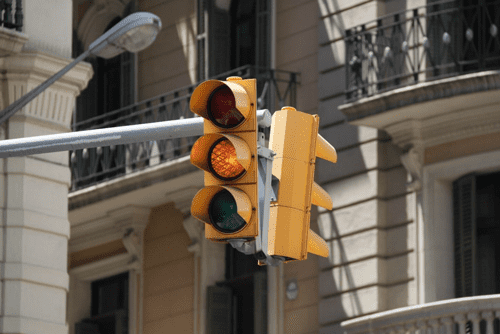
While driving and a yellow (or amber) traffic light appears ahead of you, you must stop if you can do so safely as it means the red light is about to appear. If you can’t stop safely, you are allowed to proceed through the intersection but do so with caution.
It does not mean you should speed up to make it through, just because the red light is about to appear. It also does not mean you should slam on your brakes to stop. Knowing your speed, the road conditions, and the closeness of the traffic behind help you make this a safe decision. Learn more at Trubicars!

One of the toughest tasks as a new driver is being able to remain in the middle of your lane consistently. To help you do that, look at where you think you would be in the next 15 seconds. This is roughly 2 city blocks. This will allow your peripheral vision to help you remain in the middle of the lane. Looking at the side of your lanes, such as lane markings or a curb will cause your vehicle to drift to the side. For more information, visit Trubicars.ca
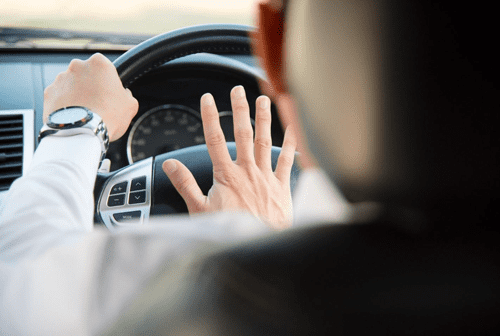
Being able to communicate with all other road users is important. Ensuring you can communicate with all the means at your disposal, including the horn, signals, brake lights, headlights, hazard lights, reverse lights, and even your hands and arms. Sending the message is just the first part of communicating. Ensuring you get the intended response completes the action. To learn more about communicating effectively, visit Trubicars.ca!

 January 10, 2025 by
January 10, 2025 by Trubicars
Trubicars
 January 10, 2025 by
January 10, 2025 by Trubicars
Trubicars
 January 3, 2025 by
January 3, 2025 by Trubicars
Trubicars
Once you acquire the knowledge provided in
those tests, you are ready to pass the test,
for the first time.
